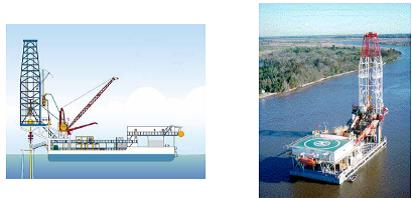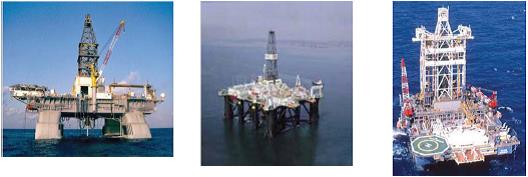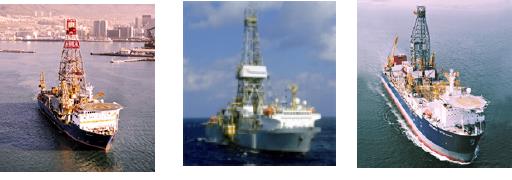Rotary drilling rigs are used for most drilling operations today. The hole is drilled by rotating a bit and applying a downward force. Generally, the bit is turned by rotating the entire drill string, using a rotary table or a Top drive at the surface, and the downward force is applied to the bit by using heavy thick walled pipe, called drill collars, in the drill string above the bit. The cuttings generated by drilling are lifted to the surface by circulating a drilling fluid down the drill string, through the bit, and up the annular space between the hole and the drill string. The cuttings are separated from the drilling fluid at the surface.
Rotary drilling rigs can be classified as land rigs and marine rigs. The main features of land rigs are portability and maximum operating depth. Land rigs are built so that the derrick can be moved easily and reused for drilling new holes. The various rigs components are skid-mounted so that the rig can be moved in units and connected easily. The jackknife, or cantilever, derrick is assembled on the ground with pins and then raised as a unit using the rig-hoisting equipment. The portable mast which is suitable for moderate depth wells usually is mounted on wheeled trucks of trailers that incorporate the hoisting machinery, engines, and derricks as a single unit. The telescoped portable mast is raised to the vertical position and then extended to full height by hydraulic pistons on the unit.

Fig 01- Land Rigs
The main features of the marine rigs are portability and maximum water depth operation. Submersible drilling barges generally are used for inland water drilling where wave action is not severe and water depths are less than 20 ft. The entire rig is assembled on the barge, and the unit is towed to the location and sunk by flooding the barge. Once drilling is completed, the water is pumped out from the barge, allowing it to be moved to the next location. After the well is completed, a platform must be built to protect the wellhead and to support the surface production equipment.
Fig 02- Drilling Barges
When water depth is less than about 350 ft, jackup can be used. The jackup is bottom supported rigs using metallic legs. On location, the legs are lowered to the bottom and the platform is jacked up above the wave action by means of hydraulic jacks.
Fig 03- Jack Up Rigs
Semisubmersible rigs are more expensive than jackup rigs and, thus, are used mostly in water depths too great for resting on bottom. Semisubmersible rigs employ large engines to position the rig over the hole dynamically. This can extend greatly the maximum operating water depth. The shape of semisubmersible rigs tends to dampen wave motion greatly regardless of wave direction. This allows its use in areas where wave action is severe.
Fig 04 -Semi-Submersible Rigs
A second type of floating vessel used in offshore drilling is the drillship. Drillships are designed with the rig equipment and anchoring system mounted on the central turret. The ship is rotated about the central turret using thrusters so that the ship always faces incoming waves. This helps to dampen wave motion.
Fig 5- Drill Ship Rigs
Offshore development drilling usually is done from fixed platforms. After the exploratory drilling program indicates the presence of sufficient petroleum reserves to justify construction costs, one or more platforms from which many directional wells can be drilled are built and placed on location. The platforms are placed so that wellbores fanning out in all directions from the platform can develop the reservoir fully. The various rig components usually are integrated into a few large modules that a derrick barge quickly can place on the platform.
Fig 7 - Platform Rigs
Large platforms allow the use of a self-contained rig- all rig components are located on the platform. A platform /tender combination can be used for small platforms. The rig tender, which is a floating vessel anchored next to the platform, contains the living quarters and many of the rig components. The rip-up time and operating cost will be less for a platform/tender operation. However, some operating time may be lost during severe weather.
Although drilling rigs differ greatly in outward appearance and method of deployment, all rotary rigs have the same basic drilling equipment. The main component parts of a rotary rig are:
- Power system
- Hoisting system
- Circulating system
- Rotary system
- Well control system





I really like your take on the issue. I now have a clear idea on what this matter is all about.. puffingbird
ReplyDelete